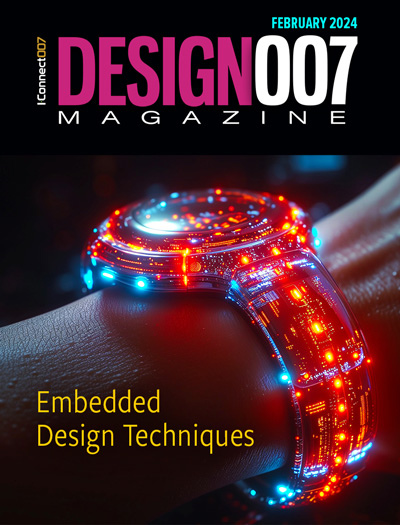-

- News
- Books
Featured Books
- design007 Magazine
Latest Issues
Current Issue
Level Up Your Design Skills
This month, our contributors discuss the PCB design classes available at IPC APEX EXPO 2024. As they explain, these courses cover everything from the basics of design through avoiding over-constraining high-speed boards, and so much more!

Opportunities and Challenges
In this issue, our expert contributors discuss the many opportunities and challenges in the PCB design community, and what can be done to grow the numbers of PCB designers—and design instructors.

Embedded Design Techniques
Our expert contributors provide the knowledge this month that designers need to be aware of to make intelligent, educated decisions about embedded design. Many design and manufacturing hurdles can trip up designers who are new to this technology.
- Articles
- Columns
Search Console
- Links
- Events
||| MENU - design007 Magazine
A Radical New Design Perspective
November 21, 2019 | Nolan Johnson, PCB007Estimated reading time: 11 minutes
I recently interviewed Gordon Kruberg, CEO of Gumstix, which was acquired by Altium recently. While Gumstix designs and sells computer hardware products, Altium bought Gumstix for the Geppetto design software. Gordon discusses how the concepts of Geppetto are likely to influence future design methods in the Altium environment.
Nolan Johnson: I’m speaking with Gordon Kruberg, who’s the head of modular hardware for Altium. You came to Altium fairly recently through an acquisition.
Gordon Kruberg: Yes, at the end of April. We founded Gumstix in 2003, originally to build computers—what are now called computers-on-module (COMs). We were the first to do a full implementation with Linux on a tiny circuit board comparable in size to a stick of gum. We took all the hard stuff about building PCs and put it onto one board. The design concept is now pretty common.
At the time, though, people were buying PC 104, and we decided to make it easy for them to take all the hard parts of the design, put them onto a computer-on-module, and automate all comparatively easy pieces, connected to power jacks, connectors, and all the forms of function that belong on the electronic device design. It worked out well for Gumstix, and then a lot of companies may or may not have modeled what we were doing; it may have been a design concept that came, but now it’s a few billion dollars a year industry. We were a tiny piece of that.
Johnson: And yet a vanguard.
Kruberg: At one point, I remember meeting a group of people in the Bay Area who had come with a comparable, because this is a few years ago, and they were selling a computer-on-module that was $9. We had decided that we weren’t going to compete in a race to the bottom for a standard product, but that we would take the other aspect of our business—the electronic design automation—and make that available widely. The high-value product that we had was not this one design COM, but it was the electronic automation and the electrical engineering behind customization that was the high value that we had.
Johnson: That makes it more obvious why you would be an Altium family member now. It’s not the hardware; it’s the software IP.
Kruberg: Exactly. We ended up taking all the work that we had done internally to make it easy for us to turn around the board; we put it online and called it Geppetto. Now, we have the original Gumstix hardware business, which is small, functional, and still tries to be at the vanguard of what’s going on with small hardware designs. We have the Geppetto service that we run, which supports Gumstix customization today. But the reason Altium bought us was so that we could take all the concepts that we’ve had. Think of it as digital continuity and automation of electrical engineering design principles so that it’s easy to design and then easy to realize a product.
And the whole idea all along, even if we look back 15 years ago, was to come up with a way to design something easily, and hit a “go button.” We’ve always called it the “go button.” Hit the “go button” and have an assembly of schematics, and layouts come together and then get expressed in a way that was easy to manufacture, or would automate for our electrical engineers all of the manufacturing processes.
Johnson: And yet the model that you’re working with is different.
Kruberg: It’s radically different. At the design phase, we try to encapsulate etching about the aspect of the design that is going to be important downstream. When we put together what we call a “Geppetto building block,” any one of the building blocks and modules that are on the Geppetto website in the library, each one is characterized by what its function is. Each one belongs to a functional group, and it’s a building block that has a functional characteristic.
Take accelerometers, for example. We have multiple accelerometers, and somebody can choose to put an accelerometer on a board. When they do that, they need to know that whatever the processor is going to support that. We embed in the interim models of all these designs things like what kind of software needs to run on that module. Before the schematic even gets put together, we have an idea of what kind of applications are going to run on the boards that are going to be built out of those building blocks. That allows us to look at digital continuity running from design intent at the beginning, all the way through to programming intent at the end, which is beyond the existing realization concept.
It’s not designing a schematic and the layout, but understanding the schematic, layout, documentation, device tree, or GPIO parameters that need to be put in place. It’s about testing concepts so that when somebody puts an accelerometer onto a board, they know that that board has to be tested in a particular way in order for the final board to be known to work. When we ship a board, we know that it works because we’ve already tested it.
Johnson: This makes the idea of functional properties orders of magnitude more meta. I’m struggling to figure out how to describe this (laughs.)Page 1 of 2
Suggested Items
Real Time with... IPC APEX EXPO 2024: Exploring IPC's PCB Design Courses with Kris Moyer
04/18/2024 | Real Time with...IPC APEX EXPOGuest Editor Kelly Dack and IPC instructor Kris Moyer discuss IPC's PCB design training and education offerings. They delve into course topics such as design fundamentals, mil/aero, rigid-flex, RF design, and advanced design concepts. They also highlight material selection for high-speed design, thermal management, and dissipation techniques. The interview wraps up with details about how to access these courses online.
Cadence Unveils Palladium Z3 and Protium X3 Systems
04/18/2024 | Cadence Design SystemsThe Palladium Z3 and Protium X3 systems offer increased capacity, and scale from job sizes of 16 million gates up to 48 billion gates, so the largest SoCs can be tested as a whole rather than just partial models, ensuring proper functionality and performance.
Signal Integrity Expert Donald Telian to Teach 'Signal Integrity, In Practice' Masterclass Globally
04/17/2024 | PRLOGDonald Telian and The EEcosystem announce the global tour of "Signal Integrity, In Practice," a groundbreaking LIVE masterclass designed to equip hardware engineers with essential skills for solving Signal Integrity (SI) challenges in today's fast-paced technological landscape.
On the Line With... Podcast Talks With Cadence Expert on Manufacturing
04/18/2024 | I-Connect007In “PCB 3.0: A New Design Methodology: Manufacturing” Patrick Davis returns to the podcast to talk about design rules. As design considerations become more and more complex, so, too, do the rulesets designers must abide by.
Designing Electronics for High Thermal Loads
04/16/2024 | Akber Roy, Rush PCB Inc.Developing proactive thermal management strategies is important in the early stages of the PCB design cycle to minimize costly redesign iterations. Here, I delve into key aspects of electronic design that hold particular relevance for managing heat in electronic systems. Each of these considerations plays a pivotal role in enhancing the reliability and performance of the overall system.


